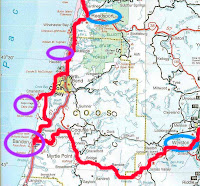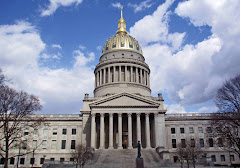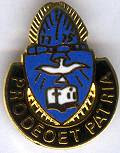The other big "attraction" within Crater Lake itself(which I called on my last post a "Large Hole" to avoid the Crater/Caldera controversy) is a rock formation which has been dubbed: The Phantom Ship. It is found over on the southeastern side of the Lake far away from The Wizard's Hat. Further, unlike The Wizard's Hat, which I called a "Heap of Cinders" in my last posting, The Phantom Ship is composed of lava left over from some of the volcanic activity associated with the site. Again, I am not a geologist. Check some other site if you wish to have a more authoritative discussion of the make-up, origin etc. of the formation.

For me, it is sufficient to say that it is a "Big Rock," in the "Large Hole." And it is big, despite the appearances. You have to remember that you are, depending upon your exact location and water level of the lake, anywhere from 700 to over 1000 feet above the surface of the Lake. According to the Guide Books it is over 300 feet lo ng. That means 2 NFL teams could have a game on the island, though I must say running a play amid the mass of rocks and pillars would be a daunting task. Further it rises about 160 feet (again, that is about 1/2 the distance of the proverbial football field), from the surface of the lake. Note well, this last number will vary due to the seasonal fluctuations in the water's depth in the lake. In other words. . .it is not a small thing. It is a "BIG ROCK!"
ng. That means 2 NFL teams could have a game on the island, though I must say running a play amid the mass of rocks and pillars would be a daunting task. Further it rises about 160 feet (again, that is about 1/2 the distance of the proverbial football field), from the surface of the lake. Note well, this last number will vary due to the seasonal fluctuations in the water's depth in the lake. In other words. . .it is not a small thing. It is a "BIG ROCK!"
And further from most angles, it does appear to resemble a ship, something like a 2-4 masted schooner depending upon how versed you are in your "rigging" and all that jazz.
But, you may say, where does it get the name "Phantom?" It is, after all, a "ship that does not move." Well, that too has a logical explanation. Actually, I've heard two.
The first one suggests that the name arises from the weather conditions at Crater Lake, not the ones we encountered, the ones that are present most of the year (more on this in a later posting). Anyway, needless to say, it is wet a lot of the time. And there is also a lot of temperature inversions, and heat difference given the large body of water acting as a heat sink. . .Again I am getting too technical, consult a science site to understand more. . . What I am saying is, most of the year, fog and mist on the surface of the lake is very common. Thus, the formation moves in and out of the surrounding misty fog, appears and disappears as if it is a "Phantom."
Yet again, if one goes over to the area around Crater Lake Lodge (more on this in a later posting), one will find some of the main overlooks, particularly the "Sinnot Memorial Overlook." From that angle, given the location of the Phamtom Ship rock, it may appear to disappear into the surrounding rocks. In the picture to the left, look carefully near the shoreline about 1/2 way up in the shot and you will find it. And since this is the area and these are the overlooks that are open for most of the year, and hence, the most visited, one would expect that many people, through the years, have experienced the Ship's "disappearence."
on this in a later posting), one will find some of the main overlooks, particularly the "Sinnot Memorial Overlook." From that angle, given the location of the Phamtom Ship rock, it may appear to disappear into the surrounding rocks. In the picture to the left, look carefully near the shoreline about 1/2 way up in the shot and you will find it. And since this is the area and these are the overlooks that are open for most of the year, and hence, the most visited, one would expect that many people, through the years, have experienced the Ship's "disappearence."
Now, whatever the reason, the end result is the same. The "Ship" has a "Phantom-like" existence for many people. But, it is, in the end, a "Big Rock" in a "Large Hole."
































